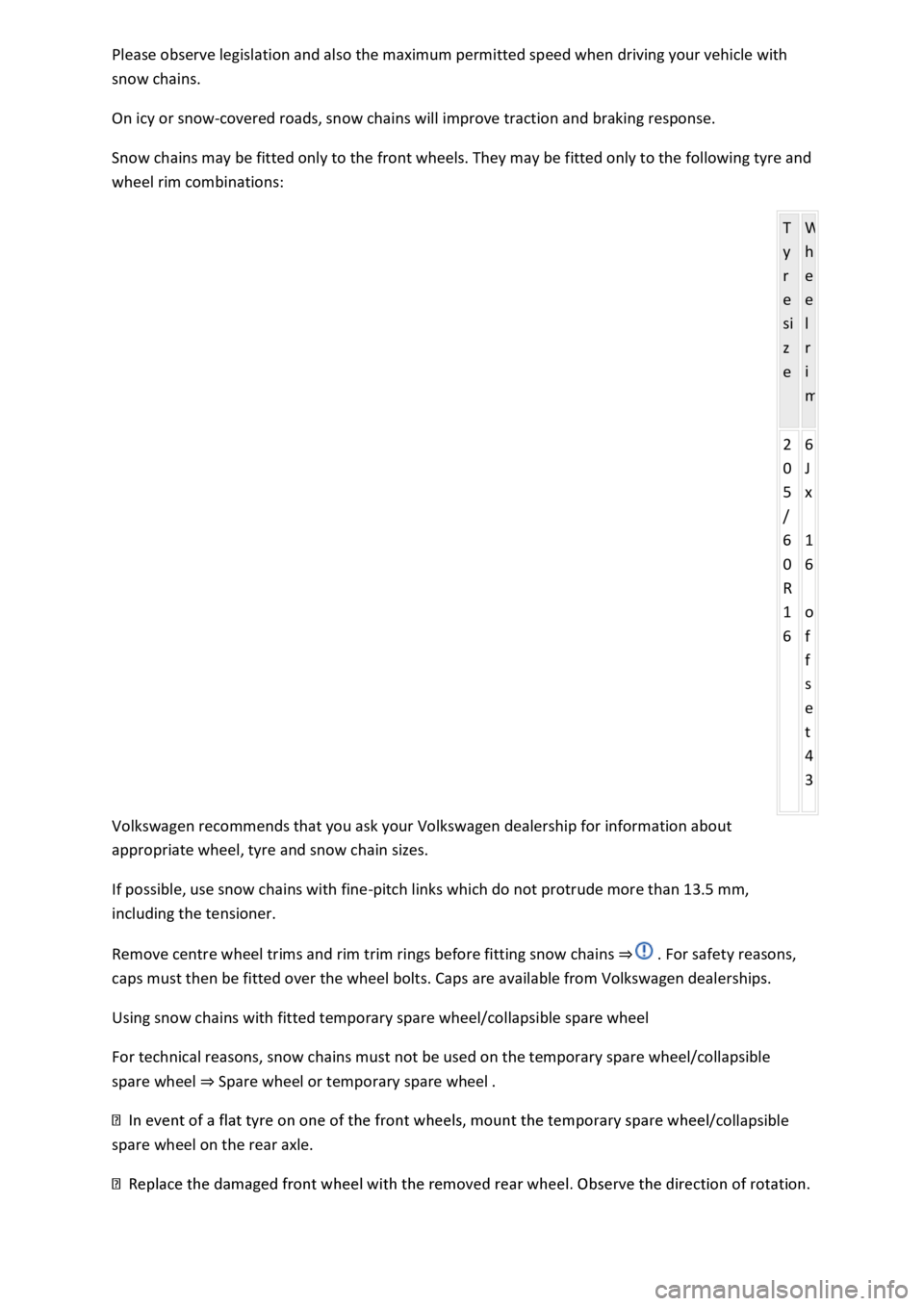wheel size VOLKSWAGEN T-ROC 2021 Owner´s Manual
[x] Cancel search | Manufacturer: VOLKSWAGEN, Model Year: 2021, Model line: T-ROC, Model: VOLKSWAGEN T-ROC 2021Pages: 502, PDF Size: 9.42 MB
Page 17 of 502

Information profiles
Various, topic-specific information profiles can be selected via the Active Info Display menu option in
the vehicle settings of the Infotainment system ⇒ Vehicle settings menu . Depending on the selected
information profile, the Active Info Display shows additional information in the centre of the round
instruments, or the round instruments are hidden and the additional information is displayed across
the whole width of the display. The following information profiles are available:
Gear. Digital display of the current gear or selected position.
Speed. Digital display of the speed.
Consumption. Graphic representation of current consumption and digital display of average
consumption.
Range. Digital display of the remaining range.
Dynamic Road Sign Display. Display of recognised road signs.
Distance travelled. Digital display of the distance covered.
Time of arrival information. Digital display of the remaining driving time, distance to the destination
and estimated time of arrival.
Acceleration. Graphic representation of longitudinal and lateral acceleration.
Assist systems. Graphic representation of various assist systems.
Height. Digital display of the current height above sea level.
Navigation. Graphic representation of arrow navigation.
Compass. Digital compass display.
Audio. Digital display of current audio playback.
The number and functions of the available information profiles can differ depending on the vehicle
equipment.
Navigation map in the Active Info Display
With some vehicle equipment levels, the Active Info Display is able to display a detailed map. To
display this map, select the Navigation menu item in the instrument cluster ⇒ Instrument cluster
menus .
The navigation map can be shown in two sizes. With the larger map size, the navigation map is
displayed over the entire width of the display. To select the preferred map size:
Press the button on the multifunction steering wheel ⇒ Instrument cluster menus to switch
between map sizes as required.
Page 18 of 502

OR: press the or arrow button on the multifunction steering wheel to select the required
map size. A frame appears around the selected option.
Press the button on the multifunction steering wheel to confirm your selection.
With some equipment levels, navigation is shown on two screens or only one. The navigation map
can be displayed on the Active Info Display and Infotainment system or only on the Infotainment
system display. In the latter case, only navigation arrows are shown on the Active Info Display.
Displays
First read and observe the introductoryinformation and safety warnings⇒Introduction
Possible instrument cluster displays
Open doors, bonnet and boot lid.
Warning and information messages.
Mileage displays.
Time ⇒ Time .
Radio and navigation information ⇒BookletInfotainment system,.
Telephone information ⇒BookletInfotainment system,.
Outside temperature.
Compass display.
Selector lever positions.
Gear-change indicator ⇒ Gear-change indicator .
Driving data display (multifunction display) and menus for various settings ⇒ Instrument cluster
menus .
Service interval display ⇒ Service interval display .
Speed warning ⇒ Instrument cluster menus .
Speed warning for winter tyres.
Start/stop system status display ⇒ Start/stop system .
Road signs detected by the Dynamic Road Sign Display system ⇒ Dynamic Road Sign Display (Sign
Assist) .
Status display for Active Cylinder Management (ACT®) ⇒ Driving economically .
Economical mode .
Engine code.
Display of driver assist systems ⇒ Driver assist systems .
Page 222 of 502

Do not slip the clutch or rest your foot on the clutch when driving offroad. When travelling over
uneven ground, you could press the clutch by mistake and lose control of the vehicle. This also
prevents power being transferred between the engine and the gearbox. In addition, driving with the
clutch partially engaged causes premature wear to the clutch lining.
Useful accessories for offroad driving
First read and observe the introductoryinformation and safety warnings⇒Introduction
The checklist contains just a few items of equipment that can be very useful for offroad driving. If
you have an instruction manual or fitting instructions for these accessories, you should always take
them with you and observe them as necessary when driving offroad.
Checklist
Useful items when driving offroad:
Water, compass, maps and torch with spare batteries.
Winch, tow bar or rope with sufficient strength.
Mobile telephone, shovel, blankets and rubber boots.
Electrical air compressor for connection to the 12-volt sockets in the vehicle to inflate the tyres.
A wooden board approx. 4 cm thick and approx. 1 metre long or an aluminium frame of similar size:
this can be used to free a vehicle stuck in the mud and provide a platform for a vehicle jack.
Snow chains, additional spare wheels, a breakdown set, jack and box spanner.
Changing gear correctly
First read and observe the introductoryinformation and safety warnings⇒Introduction
The correct choice of gear depends on the offroad terrain.
Before attempting to drive through difficult terrain it can be helpful to stop and consider which gear
you should select. After several trips offroad, you will learn which gear to select in conjunction with
the step-down ratio and differential locks for different types of terrain.
General rules
Page 395 of 502

Driving on unpaved roads for long periods or a sporty driving style can temporarily deactivate the
Tyre Pressure Loss Indicator. In the event of a malfunction, the indicator lamp will flash for 65
seconds and then light up continuously. However, the indicator lamp will go out when the road
conditions or driving style change.
Useful information about wheels and tyres
Introduction
This chapter contains information on the followingsubjects:
⇒ Handling wheels and tyres
⇒ Wheel rims and wheel bolts
⇒ Tyre pressure
⇒ Tread depth and wear indicators
⇒ Tyre damage
⇒ Spare wheel or temporary spare wheel
⇒ Tyre lettering and tyre type
⇒ Maximum load and speed range for tyres
⇒ Winter tyres
⇒ Snow chains
The tyres are the most heavily loaded and most underestimated parts of a vehicle. Tyres are very
important as the narrow tyre contact surfaces are the only contact between the vehicle and the
road.
The service life of tyres is dependent on tyre pressure, driving style, handling and correct fitting.
WARNING
New tyres or tyres which are old, worn down or damaged cannot provide full vehicle control and
braking efficiency.
injuries.
s must be fitted with radial tyres of the same type, size (rolling circumference) and
the same tread pattern.
particularly carefully for the first 600 km in order to prevent accidents and serious injury.
the tyre pressure is too low, it is possible that the tyre temperature will increase to such an extent
when driving that the tread peels off and the tyre bursts.
Page 401 of 502

First read and observe the introductoryinformation and safety warnings⇒Introduction
Information on the sticker ⇒ Fig. 194 :
Tyre pressure for the tyres on the front axle.
Tyre pressure for the tyres on the rear axle.
Note: check the tyre pressure when the tyres are cold.
Tyre pressure for partial load.
Vehicle-dependent: comfort tyre pressure for partial load.
Tyre pressure for full load.
Tyre pressure level for the spare or temporary spare wheel.
The sticker provides the correct tyre pressure for approved tyres and is located either on the driver
door pillar ⇒ Fig. 195 or inside the tank flap.
The appearance of the sticker may differ between vehicles. It may include additional tyre sizes.
The wrong tyre pressure will have a negative effect on the vehicle handling and leads to high levels
of wear or even a burst tyre ⇒ . The correct tyre pressure is particularly important at high speeds.
Comfort tyre pressure
Depending on the vehicle, the tyre pressure sticker may show details of a comfort tyre pressure
⇒ Fig. 194③ . The comfort tyre pressure allows increased driving comfort. Fuel consumption may
increase when driving with comfort tyre pressure.
Checking the tyre pressure
tyres. Tyre pressure is always higher in warm tyres than it is in cold tyres. For this reason, never
reduce the pressure in warm tyres to adjust the tyre pressure.
⇒ Fig. 194④ .
and observe the
information on the tyre monitoring system.
which is given on the sidewall of the tyre.
WARNING
Page 410 of 502

Examples:
78425 kg81462 kg83487 kg85515 kg87545 kg88560 kg91615 kg92630 kg93650 kg95690 kg97730
kg99775 kg100800 kg101825 kg102850 kg103875 kg104900 kg
Speed index
The speed index indicates the maximum permitted speed that may be driven with the tyres.
Pmax. 150 km/h (93 mph)Qmax. 160 km/h (99 mph)Rmax. 170 km/h (106 mph)Smax. 180 km/h
(112 mph)Tmax. 190 km/h (118 mph)Umax. 200 km/h (125 mph)Hmax. 210 km/h
(130 mph)Vmax. 240 km/h (149 mph)Wmax. 270 km/h (168 mph)Ymax. 300 km/h
(186 mph)Zover 240 km/h (149 mph)
Some tyre manufacturers use the code ZR for tyres with a maximum permitted speed of over
240 km/h (149 mph).
a) The TIN is the tyre serial number.
Maximum load and speed range for tyres
First read and observe the introductoryinformation and safety warnings⇒Introduction
Vehicles in the EU and the so-called EU user states are issued an EC Certificate of Conformity. This
details the size, diameter, load rating and speed range of all tyres approved by Volkswagen for the
relevant vehicle type.
The type plate shows whether there is an EC certificate of conformity for this particular vehicle. The
type plate can be seen on the lower part of the door pillar when the driver door is open ⇒ Technical
data .
that the vehicle has an EC certificate of
conformity.
certificate of conformity.
Winter tyres
First read and observe the introductoryinformation and safety warnings⇒Introduction
Winter or all-year tyres improve the handling and braking response in winter conditions. Volkswagen
recommends that winter tyres be fitted to the vehicle at temperatures below +7°C (+45°F) or in
winter conditions.
Winter tyres and all-year tyres lose a large degree of their effectiveness for winter conditions when
the tread is worn down to a depth of 4 mm.
The following applies when using winter tyres:
-specific legal requirements.
r wheels at the same time.
Page 411 of 502

peed index ⇒ .
Speed limitation
Winter tyres have a speed limit depending on the speed index ⇒ Tyre lettering and tyre type .
Speed warning settings can be made and adjusted in the Infotainment system using the
button and the and Tyres function buttons.
If you use V-rated winter tyres, the speed limits and required tyre pressure are determined by the
engine size. In this case, always ask a Volkswagen dealership about the maximum permitted speed
and required tyre pressure.
All-wheel drive (4MOTION)
Thanks to its all-wheel drive, the vehicle has good traction in winter conditions, even with the
standard tyres. Nevertheless, Volkswagen still recommends that winter tyres or all-year tyres should
be fitted on all four wheels in winter, above all because this will give improved braking efficiency.
Observe information on snow chains⇒ Snow chains .
WARNING
The improved driving characteristics afforded by the winter tyres in winter conditions should not
encourage you to take any risks.
driving style to suit visibility, weather, road and traffic conditions.
The vehicle handling is better if summer tyres are fitted at temperatures above +7°C (+45°F). The
rolling noise is quieter, the tyre wear lower and the energy efficiency higher in this case.
In vehicles with a Tyre Pressure Loss Indicator, the system has to re-synchronise after wheels are
changed ⇒ Tyre monitoring system .
Volkswagen dealerships can provide details on permissible winter tyre sizes.
Snow chains
First read and observe the introductoryinformation and safety warnings⇒Introduction
Page 412 of 502

Please observe legislation and also the maximum permitted speed when driving your vehicle with
snow chains.
On icy or snow-covered roads, snow chains will improve traction and braking response.
Snow chains may be fitted only to the front wheels. They may be fitted only to the following tyre and
wheel rim combinations:
T
y
r
e
si
z
e
W
h
e
e
l
r
i
m
2
0
5
/
6
0
R
1
6
6
J
x
1
6
o
f
f
s
e
t
4
3
Volkswagen recommends that you ask your Volkswagen dealership for information about
appropriate wheel, tyre and snow chain sizes.
If possible, use snow chains with fine-pitch links which do not protrude more than 13.5 mm,
including the tensioner.
Remove centre wheel trims and rim trim rings before fitting snow chains ⇒ . For safety reasons,
caps must then be fitted over the wheel bolts. Caps are available from Volkswagen dealerships.
Using snow chains with fitted temporary spare wheel/collapsible spare wheel
For technical reasons, snow chains must not be used on the temporary spare wheel/collapsible
spare wheel ⇒ Spare wheel or temporary spare wheel .
llapsible
spare wheel on the rear axle.
Page 491 of 502

when driving into
parking spaces
with high kerbs or
fixed boundaries.
Objects that
protrude from the
ground can
damage the
bumper and other
components when
parking the
vehicle.pecified
values can vary
due to different
wheel rim and tyre
sizes, additional
equipment,
different model
versions or
retrofitted
accessories, and
also for special
vehicles and
vehicles that have
been
manufactured for
other
countries. Fig. 217 :
Value
Ⓐ Width (from
exterior mirror
to exterior
mirror)
1,992
mm
Ⓑ Width 1,819
mm
Ⓒ Front track 1,538
mm –
1,546
mm
Rear track 1,533
mm –
1,541
mm
Page 492 of 502

when driving into
parking spaces
with high kerbs or
fixed boundaries.
Objects that
protrude from the
ground can
damage the
bumper and other
components when
parking the
vehicle.pecified
values can vary
due to different
wheel rim and tyre
sizes, additional
equipment,
different model
versions or
retrofitted
accessories, and
also for special
vehicles and
vehicles that have
been
manufactured for
other
countries. Fig. 217 :
Value
Ⓓ Height to the
upper edge of
the roof at
kerb weighta)
1,533
mm
Height at kerb
weighta) with
navigation
aerial
1,573
mm
Height to the
roof railing at
kerb weighta)
1,552
mm
Ⓔ Length with
fitted towing
bracket (when
supplied from
4,330
mm